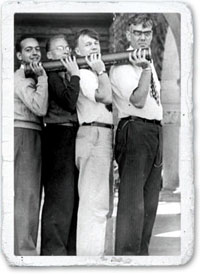

Wednesday - May 16, 2007
SLAC Today is
available online at:
http://today.slac.stanford.edu
In this issue:
Celebrating Sixty Years of Accelerated Electrons
Profile: Al Baker: A Man with a Plan
SLAC's Information Research Summit
Reminder: Stanford Jazz Orchestra Concert Tonight
 |
 |
|
Wednesday - May 16, 2007 |
Celebrating Sixty Years of Accelerated Electrons
Professor William W. Hansen (right) and graduate students Stanley Kaisel,
Clarence Carlson, and William Kennedy hold a section of the first Stanford traveling wave electron linear accelerator. (Image courtesy of SLAC Archives.)
Six decades ago, two teams, working separately at the Telecommunications Research Establishment in the United Kingdom and at Stanford University, achieved a major landmark in the history of physics: accelerating a beam of electrons with a linear accelerator. The British group was the first to succeed in its experiments in December of 1946, followed closely by the Stanford team, led by Professor William Webster Hansen. On April 28, 1947, Hansen sent a report to the Office of Naval Research, his sponsor, reporting the good news: "We have accelerated electrons." To commemorate the 60th anniversary of this achievement, SLAC is holding a celebration in the Panofsky Auditorium at 9:00 a.m. on May 23. The event is combined with the workshop on the U.S. High Gradient Research Collaboration for Future Colliders, which immediately follows on the afternoon of May 23 and continues through May 25. Registration is required for the workshop, but everyone is invited to attend the anniversary celebration. SLAC's Deputy Director Persis Drell will deliver welcoming remarks, which will be followed by an opening statement by Pief Panofsky, SLAC's first director. SLAC's Greg Loew will then give a talk on the beginnings of linear electron accelerator work in the Stanford Physics Department from 1932 to 1952, which will illustrate the conditions under which Professor Hansen and his colleagues conducted research at the university at the time. Read more... |
||
|
|
||
 Al Baker:
|
SLAC's Information Research Summit
Particle physics and particle astrophysics have always been at the forefront of the information revolution. But the fields will need many new ways to connect people with information, and soon, if the science is to progress at full speed, said participants in last week's Particle Physics and Astrophysics Information Resources Summit at SLAC. The meeting drew 35 researchers, journal editors and information specialists from around the world to brainstorm ideas for the next generation of scientific communication. "A lot of these groups that provide this kind of information have never talked to each other-or have maybe talked occasionally, but not in a deep way," said Travis Brooks, manager of the SPIRES databases at the SLAC Library. "We really should be pooling resources." Brooks organized the summit together with Library Manager Ann Redfield and Pat Kreitz, the lab's director of Technical Information Services. The three-day event explored new ways to quickly find information and to link ever more complex information in a meaningful fashion. For instance, a published paper might be linked to recordings of talks the authors had given, to underlying experimental data, to the analysis software used, to interactive graphics, and even to movies. No matter what the information, it's useless if people can't find it quickly and easily, said Anurag Acharya, creator of Google Scholar, which searches the full texts of research publications. "Good things can come from anywhere," he said, "but what you do not know—what you can't find—you can't build on.'' Stanford Jazz Orchestra Concert Tonight
|
Events (see all | submit)
Access (see all)Announcements
|
| | ||
|
|
||
 <%
Response.AddHeader "Last-modified", getArticleDate()
'Response.AddHeader "Last-modified","Mon, 01 Sep 1997 01:03:33 GMT"
'Monday, December 06, 2010
%>
<%
Response.AddHeader "Last-modified", getArticleDate()
'Response.AddHeader "Last-modified","Mon, 01 Sep 1997 01:03:33 GMT"
'Monday, December 06, 2010
%>View online at http://today.slac.stanford.edu/. |
||